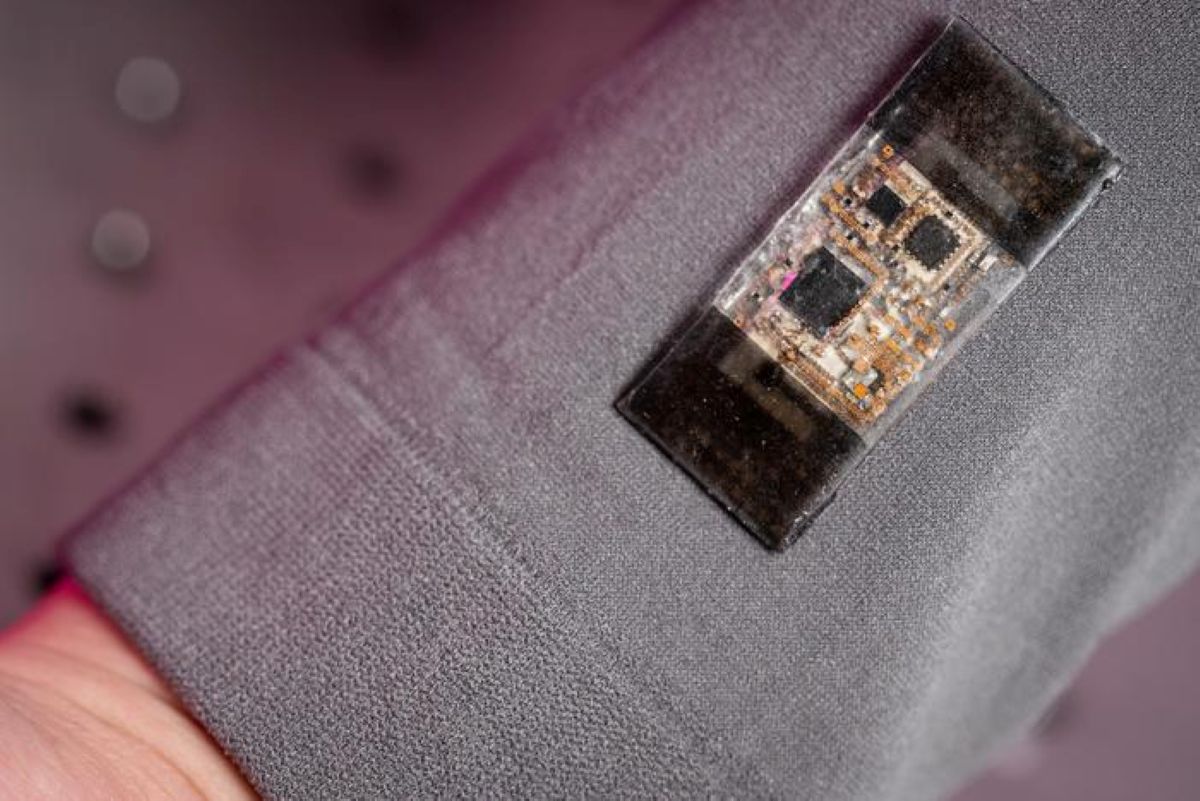Summary: A new wearable system uses stretchable electronics and artificial intelligence to interpret human gestures with high accuracy even in chaotic, high-motion environments. Unlike traditional gesture-based wearables that fail under movement noise, this patch-based device filters interference in real time, allowing gestures to reliably control machines such as robotic arms.
The technology has been validated in conditions ranging from running to simulated ocean turbulence, demonstrating robust performance under real-world disturbances. This advance brings gesture-based human-machine interaction closer to practical daily use across rehabilitation, industrial work, emergency response, and underwater operations.
Key Facts:
- Noise-Tolerant Control: Deep-learning algorithms remove motion noise in real time, enabling gestures to control machines reliably.
- Robust Across Environments: Validated during running, vibration, combined disturbances, and turbulent ocean wave simulations.
- Next-Gen Wearable Design: Integrates stretchable sensors, Bluetooth microcontroller, and a soft battery into a compact armband system.
Source: UCSD
Engineers at the University of California San Diego have developed a next-generation wearable system that enables people to control machines using everyday gestures — even while running, riding in a car or floating on turbulent ocean waves.
The system, published on Nov. 17 in Nature Sensors, combines stretchable electronics with artificial intelligence to overcome a long-standing challenge in wearable technology: reliable recognition of gesture signals in real-world environments.

Wearable technologies with gesture sensors work fine when a user is sitting still, but the signals start to fall apart under excessive motion noise, explained study co-first author Xiangjun Chen, a postdoctoral researcher in the Aiiso Yufeng Li Family Department of Chemical and Nano Engineering at the UC San Diego Jacobs School of Engineering. This limits their practicality in daily life.
“Our system overcomes this limitation,” Chen said. “By integrating AI to clean noisy sensor data in real time, the technology enables everyday gestures to reliably control machines even in highly dynamic environments.”
The technology could enable patients in rehabilitation or individuals with limited mobility, for example, to use natural gestures to control robotic aids without relying on fine motor skills. Industrial workers and first responders could potentially use the technology for hands-free control of tools and robots in high-motion or hazardous environments.
It could even enable divers and remote operators to command underwater robots despite turbulent conditions. In consumer devices, the system could make gesture-based controls more reliable in everyday settings.
The work was a collaboration between the labs of Sheng Xu and Joseph Wang, both professors in the Aiiso Yufeng Li Family Department of Chemical and Nano Engineering at the UC San Diego Jacobs School of Engineering.
To the researchers’ knowledge, this is the first wearable human-machine interface that works reliably across a wide range of motion disturbances. As a result, it can work with the way people actually move.
The device is a soft electronic patch that is glued onto a cloth armband. It integrates motion and muscle sensors, a Bluetooth microcontroller and a stretchable battery into a compact, multilayered system.
The system was trained from a composite dataset of real gestures and conditions, from running and shaking to the movement of ocean waves. Signals from the arm are captured and processed by a customized deep-learning framework that strips away interference, interprets the gesture, and transmits a command to control a machine — such as a robotic arm — in real time.
“This advancement brings us closer to intuitive and robust human-machine interfaces that can be deployed in daily life,” Chen said.
The system was tested in multiple dynamic conditions. Subjects used the device to control a robotic arm while running, exposed to high-frequency vibrations, and under a combination of disturbances.
The device was also validated under simulated ocean conditions using the Scripps Ocean-Atmosphere Research Simulator at UC San Diego’s Scripps Institution of Oceanography, which recreated both lab-generated and real sea motion. In all cases, the system delivered accurate, low-latency performance.
Originally, this project was inspired by the idea of helping military divers control underwater robots. But the team soon realized that interference from motion wasn’t just a problem unique to underwater environments. It is a common challenge across the field of wearable technology, one that has long limited the performance of such systems in everyday life.
“This work establishes a new method for noise tolerance in wearable sensors,” Chen said. “It paves the way for next-generation wearable systems that are not only stretchable and wireless, but also capable of learning from complex environments and individual users.”
Full study: “A noise-tolerant human-machine interface based on deep learning-enhanced wearable sensors.” Co-first authors on the study are UC San Diego researchers Xiangjun Chen, Zhiyuan Lou, Xiaoxiang Gao and Lu Yin.
Funding: This work was supported by the Defense Advanced Research Projects Agency (DARPA, contract number HR001120C0093).
Key Questions Answered:
A: It reliably interprets gesture signals even during intense motion, overcoming a major limitation of current gesture-based wearables.
A: A stretchable sensor patch captures motion signals, while a deep-learning system filters noise in real time before sending commands to external machines.
A: Patients in rehabilitation, people with mobility limitations, industrial workers, first responders, divers, and consumers needing stable gesture-based controls.
Editorial Notes:
- This article was written by a Neuroscience News editor.
- Journal paper reviewed in full.
- Additional context added by our staff.
Author: Liezel Labios
Source: UCSD
Contact: Liezel Labios – UCSD
Image: The image is credited to David Baillot/UC San Diego Jacobs School of Engineering
Original Research: Closed access.
“A noise-tolerant human–machine interface based on deep learning-enhanced wearable sensors” by Sheng Xu et al. Nature Sensors
Abstract
A noise-tolerant human–machine interface based on deep learning-enhanced wearable sensors
Wearable human–machine interfaces with inertial measurement units (IMUs) are widely applied across healthcare, robotics and interactive technologies. However, extracting reliable signals remains challenging owing to motion artefacts in real-world environments.
Here we present a human–machine interface capable of tolerating diverse motion artefacts through deep learning-enhanced wearable sensors. The system integrates a six-channel IMU, an electromyography module, a Bluetooth microcontroller unit and a stretchable battery, enabling wireless capture and transmission of gesture signals.
A convolutional neural network trained on a composite dataset of gestures and motion artefacts extracts robust signals, while parameter-based transfer learning improves the generalizability of the network across users.
A sliding-window approach converts the extracted gesture signals into real-time, continuous control of a robotic arm during dynamic activities such as running, high-frequency vibration, posture changes, oceanic wave motion and combinations of these.
This work demonstrates the potential of wearable human–machine interfaces for complex real-world applications.






